Construction of Landscape Heritage Corridors in Ethnic Minority Villages Based on LCA-MSPA-MCR Framework: A Case Study of the Nanling Ethnic Corridor Region in China
Abstract
1. Introduction
2. Materials and Methods
2.1. Study Area
2.2. Data Sources
2.3. Research Methods
2.3.1. Landscape Resource Assessment of the Nanling Ethnic Corridor Based on LCA
- Landscape character assessment system. The construction of the landscape character assessment system is guided by four principles: systematicness, representativeness, data accessibility, and relevance to the study area. The principle of systematicness ensures coverage of the core dimensions of landscape characteristics; representativeness ensures that the elements effectively reflect the regional distinctiveness of the Nanling Ethnic Corridor; accessibility is based on available data sources and their quality; and relevance emphasizes the close connection between the elements and the research theme. By integrating the physical geographic system and unique cultural history of the Nanling Ethnic Corridor, and referencing practical experiences from regions such as Gwangju, South Korea [28], and Israel [29], as well as research findings by scholars like Khalilah Zakariya [30], this study comprehensively selects 31 variables across 8 subcategories from two element types—natural and human factors (Table 2).
- 2.
- Landscape Character Assessment. In ArcGIS 10.8, the study area was divided into 213,769 landscape spatial units at a scale of 1 km × 1 km. A connection matrix between landscape feature elements and spatial units was constructed, where “presence” was assigned a value of “1” and “absence” was assigned a value of “0.” This scale was referenced from the landscape character assessment grid division standard proposed by Tudor [34] and was optimized based on the regional area and topographic complexity of the Nanling Ethnic Corridor. The Nanling Ethnic Corridor is a macro-scale geographical region, extending approximately 800 km from east to west and encompassing a total area of over 230,000 square kilometers. In large-scale regional studies such as those of the Nanling Ethnic Corridor, a grid resolution of 1 km × 1 km can effectively reflect the overall distribution trends of regional landscape patterns at a macro level, while simultaneously possessing the capability to identify local topographic variations and landscape heterogeneity at a micro level [35]. Compared to larger grid scales such as 2 km × 2 km [36], this resolution effectively avoids the loss of local topographic information. In contrast to finer grid scales such as 0.5 km × 0.5 km [37], it significantly reduces data redundancy and improves computational efficiency while maintaining identification accuracy [38]. On this basis, two-step cluster analysis in SPSS 27 processed the correlation matrix to preliminarily classify landscape character types within the Nanling Ethnic Corridor, generating preliminary zoning schematics. Finally, on the basis of 1–2 sample sites for each landscape feature type, the final landscape feature map was obtained by using the comprehensive method of eCognition 9.0 analysis and artificial visual interpretation.
- 3.
- Landscape Value Evaluation. This study combined expert evaluation with stakeholder engagement to construct a landscape value assessment system, balancing scientific rigor with social acceptability.
2.3.2. Landscape Source Identification via MSPA and Connectivity Analysis
- Identify the initial source. MSPA segmented the grid image through image processing technology to identify habitat patches and corridors that play an important role in landscape connectivity in the study area at the pixel level [48]. The landscape value evaluation results were regrouped through reclassification. Areas scoring higher than 6.0 in landscape value were selected as foreground data for MSPA. This threshold was determined based on the frequency distribution of landscape value scores. Scores above 6.0 corresponded to the top 26.3% of the cumulative frequency, which objectively represented high-value landscape areas, thereby ensuring the typicality and representativeness of the foreground data [49]. Then, within the Guidos Toolbox 3.0 platform, the 8-neighborhood analysis and a 40 m edge width parameter were configured to perform MSPA, with areas larger than 50 km2 to be extracted as the initial source.
- 2.
- Determine the final landscape source. Commonly employed landscape connectivity indices include the Integral Index of Connectivity (IIC), possible connectivity index (PC), and the Delta values for probability index of connectivity (dPC). The IIC and the PC were employed to quantify landscape connectivity to identify critical landscape elements [53]. The dPC particularly highlighted the significance of patches and effectively assessed the connectivity of core patches [54]. Based on the average distance between various ethnic cultural communities in the Nanling Ethnic Corridor, the connectivity probability for source patches was set to 0.5, with a distance threshold of 50 km in Conefor 2.6, to calculate IIC and PC. The patch importance index (dI) was introduced to quantify the functional significance of source patches, and patches with dI > 0.5 were ultimately selected as the key landscape sources [55]. The calculation formula is outlined as follows:
2.3.3. Heritage Corridor Construction via MCR Model
- Resistance factor indicator. To address spatial restructuring challenges in urban–rural contexts under population shrinkage, this study conceptualizes rural settlement reorganization as a process of overcoming spatial resistance. The MCR model simulates this process to identify least-cost paths generated by ethnic villages traversing comprehensive spatial resistance [56]. From the perspective of cultural heritage corridors, the magnitude of the resistance value reflects the importance of a given factor in influencing cultural spatial movement. A higher resistance value indicates a stronger capacity of that factor to either “facilitate” or “hinder” cultural connectivity, making it a dominant factor in the model. Through field surveys and a review of existing relevant studies [57,58,59,60,61,62], and considering the significant cultural and social attributes of ethnic villages as well as the unique, fragmented mountainous terrain of the Nanling Ethnic Corridor region, land cover, elevation, slope, topographic relief index (TRI), and traffic accessibility (distance to roads) were ultimately selected as resistance factors. Among these, land cover and slope have the highest resistance range (0–500), followed by traffic accessibility (0–200), while elevation and TRI have the lowest resistance range (0–100). The classification criteria and assigned resistance values for each factor are as follows (Table 5):
- 2.
- Calculate the composite resistance surface. By weighted overlay of five resistance factors, a comprehensive resistance surface was constructed (Formulas (4)–(5)). The global resistance value of the ethnic village heritage corridor was calculated using the Cost Distance tool in ArcGIS 10.8.
- 3.
- Topology-Optimized Heritage Corridor Alignment. Functioning as spatial linkages connecting ethnic village heritage nodes, heritage corridors serve dual roles in cultural conservation and public service facility coordination [63]. Using the Model Builder tool in ArcGIS 10.8, this study generated multiple global potential heritage corridor paths in batches by integrating the comprehensive resistance surface, cost distance tool, and spatial distribution of ethnic villages as key parameters. To address the inefficiency caused by extensive invalid or redundant path computations resulting from global cross-operations, a network node optimization method based on topological theory is introduced. This method designates core ethnic villages within the landscape source areas as locally critical nodes for prioritized connectivity, thereby enhancing the overall efficiency of heritage corridor network construction. Subsequently, topological analysis tools are employed to evaluate the connectivity, clustering coefficient, and path length of different heritage corridor route alternatives, identifying primary and secondary heritage corridors to form a heritage corridor network for ethnic villages in the Nanling Ethnic Corridor.
3. Results
3.1. Landscape Character Assessment Results
3.1.1. Landscape Character Identification Results
3.1.2. Landscape Value Assessment Results
3.1.3. Landscape Source Identification Results
3.2. Heritage Corridor Construction Results
3.2.1. Composite Resistance Surface and Suitability Zoning Results
3.2.2. Heritage Corridor Route Selection Results
3.2.3. Spatial Pattern Construction of Heritage Corridor
4. Discussion
4.1. Ecological Risks: Challenges of Climate Change to Corridor Feasibility
4.2. Socio-Cultural Risks: Concerns over Cultural Commodification and Gentrification
4.3. Model Applicability: Potential for Cross-Regional and Cross-Cultural Application
5. Conclusions
Author Contributions
Funding
Data Availability Statement
Acknowledgments
Conflicts of Interest
Abbreviations
| ICOMOS | International Council on Monuments and Sites |
| MCR | Minimum Cumulative Resistance |
| ESM | Environmental Space Model |
| CEC | Circuit Effective Conductance |
| ROS | Recreation Opportunity Spectrum |
| CAP | Conservation Action Planning |
| GIS | Geographic Information System |
| RS | Remote Sensing |
| CBA | Cost–Benefit Analysis |
| LCA | Landscape Character Assessment |
| MSPA | Morphological Spatial Pattern Analysis |
| DEM | Digital Elevation Model |
| CNLUCC | China 30 m Resolution Land Use/Cover Data |
| RESDC | Resource and Environmental Science Data Center |
| AHP | Analytic Hierarchy Process |
| CR | Consistency Ratio |
| PC | Probability of Connectivity Index |
| IIC | Integral Index of Connectivity |
| TRI | Topographic Relief Index |
References
- Population Division of the United Nations Department of Economic and Social Affairs. World Population Prospects 2023; United Nations: New York, NY, USA, 2023. [Google Scholar]
- National Bureau of Statistics. China Population Census Yearbook 2020; China Statistics Press: Beijing, China, 2021. [Google Scholar]
- Zhang, P.; Pu, H. Flexible Control of Urban Development Intensity in Response to Population Shrinkage: A Case Study of Shantou City. Buildings 2025, 15, 1378. [Google Scholar] [CrossRef]
- Wang, D.; Wei, X.D.; Yan, X.Q.; Sohaib, O. A Study on Sustainable Design of Traditional Tujia Village Architecture in Southwest Hubei, China. Buildings 2024, 14, 27. [Google Scholar] [CrossRef]
- Zhang, X.Z.; Ren, Y.Y.; Lv, J.; Geng, Y.H.; Su, C.X.; Ma, R.Q. Morphological Evolution and Socio-Cultural Transformation in Historic Urban Areas: A Historic Urban Landscape Approach from Luoyang, China. Buildings 2025, 15, 1373. [Google Scholar] [CrossRef]
- Del Curto, D.; Garzulino, A.; Menini, G.; Schiesaro, C. Sustainable Conservation and Management of a 20th-Century Landscape in the Alps: The Former Sanatorium Village of Sondalo. Sustainability 2022, 14, 7424. [Google Scholar] [CrossRef]
- Su, G.; Okahashi, H.; Chen, L. Spatial Pattern of Farmland Abandonment in Japan: Identification and Determinants. Sustainability 2018, 10, 3676. [Google Scholar] [CrossRef]
- Zou, M.H. Effectiveness Evaluation and Adaptive Management Model Construction of Mount Wutai World Cultural Landscape Heritage Management. Master’s Thesis, Nanchang University, Nanchang, China, 2022. (In Chinese). [Google Scholar]
- ICOMOS-IFLA. ICOMOS-IFLA Principles Concerning Rural Landscapes as Heritage; ICOMOS: New Delhi, India, 2017. [Google Scholar]
- Ministry of Finance; Ministry of Housing and Urban-Rural Development. Notice on Organizing the Application for 2024 Demonstration of Concentrated and Contiguous Protection and Utilization of Traditional Villages: Cai Ban Jian [2024] No. 15 [EB/OL]; Office of the Central Financial and Economic Affairs Commission of the Communist Party of China: Beijing, China, 2024. Available online: https://www.mof.gov.cn (accessed on 15 June 2025).
- Zhang, T.X.; Yang, Y.L.; Fan, X.; Ou, S.Y. Corridors Construction and Development Strategies for Intangible Cultural Heritage: A Study about the Yangtze River Economic Belt. Sustainability 2023, 15, 13449. [Google Scholar] [CrossRef]
- Yue, F.T.; Li, X.Q.; Huang, Q.; Li, D. A Framework for the Construction of a Heritage Corridor System: A Case Study of the Shu Road in China. Remote Sens. 2023, 15, 4650. [Google Scholar] [CrossRef]
- Chen, J.L.; Zhao, X.X.; Wang, H.Q.; Yan, J.X.; Yang, D.; Xie, K. Portraying Heritage Corridor Dynamics and Cultivating Conservation Strategies Based on Environment Spatial Model: An Integration of Multi-source Data and Image Semantic Segmentation. Herit. Sci. 2024, 12, 419. [Google Scholar] [CrossRef]
- Wu, Y.; Miao, M.R.; Wu, Y.L.; Zhu, H.; Li, X.B.; Candeias, A. The Research on the Construction of Traditional Village Heritage Corridors in the Taihu Lake Region Based on the Current Effective Conductance (CEC) Theory. Buildings 2025, 15, 472. [Google Scholar] [CrossRef]
- Shen, H.Q. Review of National Park Visitor Experience Indicators: A Case Study of ROS, LAC and VERP. Landsc. Archit. 2013, 5, 86–91. (In Chinese) [Google Scholar]
- Que, Z.S.; Hu, Y.M.; Li, J.H.; Li, H.Y.; Zhao, S.C.; Yang, J.; Nie, X.W. The Empirical Study of Land Use Zoning Method based on MAPGIS. J. Anhui Agric. Sci. 2009, 37, 1843–1844. (In Chinese) [Google Scholar]
- Yang, R. On the Development Trend of World National Park Movement. Chin. Landsc. Archit. 2003, 7, 10–15. (In Chinese) [Google Scholar]
- Huang, Y.H.; Shen, S.Y.; Hu, W.M.; Li, Y.R.; Li, G. Construction of Cultural Heritage Tourism Corridor for the Dissemination of Historical Culture: A Case Study of Typical Mountainous Multi-Ethnic Area in China. Land 2023, 12, 138. [Google Scholar] [CrossRef]
- Xie, Y.S.; Wang, Q.N.; Xie, M.Q.; Shibata, S. Construction Feasibility Evaluation for Potential Ecological Corridors under Different Widths: A Case Study of Chengdu in China. Landsc. Ecol. Eng. 2023, 19, 381–399. [Google Scholar] [CrossRef]
- Zhang, Z.Z.; Meerow, S.; Newell, J.P.; Lindquist, M. Enhancing Landscape Connectivity through Multifunctional Green Infrastructure Corridor Modeling and Design. Urban For. Urban Green. 2019, 38, 305–317. [Google Scholar] [CrossRef]
- Zhang, L. Study on the Development of Railway Location Design System Based on GIS. Master’s Thesis, Southwest Jiaotong University, Chengdu, China, 2007. (In Chinese). [Google Scholar]
- Jurković, Ž.; Hadzima-Nyarko, M.; Lovoković, D. Railway Corridors in Croatian Cities as Factors of Sustainable Spatial and Cultural Development. Sustainability 2021, 13, 6928. [Google Scholar] [CrossRef]
- Feng, B.; Ma, Y.C. Network Construction for Overall Protection and Utilization of Cultural Heritage Space in Dunhuang City, China. Sustainability 2023, 15, 4579. [Google Scholar] [CrossRef]
- Jiang, N.; Wu, J.Y.; Ma, Y.C.; Jia, Y.; Zhao, D. Research on the Evaluation Criteria of Rural Landscape Resources under the Background of New Era–From the Perspective of Building an Ecological, Livable and Beautiful Countryside. Landsc. Des. 2024, 4, 8–11. (In Chinese) [Google Scholar]
- Li, Y.J.; Li, S. On Review and Prospect of the Ethinc Corridor in South Five Ridege. J. Guangxi Norm. Univ. (Philos. Soc. Sci. Ed.) 2016, 5, 67–73. (In Chinese) [Google Scholar]
- Wang, Y.L. Research on Chinese and Foreign Traffic and Belief Space; The Commercial Press: Beijing, China, 2011. [Google Scholar]
- Ma, G.Q. On Anthropological Location and Conntataion of Nanling Ethnic Corridor. J. Guangxi Norm. Univ. (Philos. Soc. Sci. Ed.) 2013, 3, 84–90. (In Chinese) [Google Scholar]
- Kim, K.; Pauleit, S. Landscape Character, Biodiversity and Land Use Planning: The Case of Kwangju City Region, South Korea. Land Use Policy 2007, 24, 264–274. [Google Scholar] [CrossRef]
- Trop, T. From knowledge to action: Bridging the Gaps toward Effective Incorporation of Landscape Character Assessment Approach in Land-use Planning and Management in Israel. Land Use Policy 2017, 61, 220–230. [Google Scholar] [CrossRef]
- Zakariya, K.; Ibrahim, P.H.; Abdul Wahab, N.A. Conceptual Framework of Rural Landscape Character Assessment to Guide Tourism Development in Rural Areas. J. Constr. Dev. Ctries. 2019, 24, 85–99. [Google Scholar] [CrossRef]
- Yang, Y.; Hu, J.; Liu, D.J.; Li, Y.J.; Chen, Y.; Hu, S.L. Spatial Differentiation of Ethnic Traditional Villages in Guizhou Province and the Influencing Factors. J. Arid. Land Resour. Environ. 2022, 36, 178–185. (In Chinese) [Google Scholar]
- Gong, S.S.; Li, Z.M.; Hu, J.; Wei, Y.H. The Spatial Distribution and Evolution of Ancient Villages in Shanxi Province. Sci. Geogr. Sin. 2017, 37, 416–425. (In Chinese) [Google Scholar]
- Standardization Administration of the People’s Republic of China. Current Land Use Classification; China Statistics Press: Beijing, China, 2021. [Google Scholar]
- Tudor, C. An Approach to Landscape Character Assessment; Natural England: London, UK, 2014. [Google Scholar]
- Rosa, M. Chefaoui. Landscape Metrics as Indicators of Coastal Morphology: A Multi-scale Approach. Ecol. Indic. 2014, 45, 139–147. [Google Scholar]
- Wu, J.; Shen, W.; Sun, W.; Tueller, P.T. Empirical Patterns of the Effects of Changing Scale on Landscape Metrics. Landscape Ecol. 2002, 17, 761–782. [Google Scholar] [CrossRef]
- Liu, L.Y.; Zhang, L.; Song, Y.H. Landscape Character Assessment of Three Parallel Rivers Natural Heritage Sites. J. West China For. Sci. 2024, 53, 111–118. (In Chinese) [Google Scholar]
- Peng, J.; Dang, W.X.; Liu, Y.X.; Zong, M.L.; Hu, X.X. Review on Landscape Ecological Risk Assessment. Acta Geogr. Sinca 2015, 70, 664–677. (In Chinese) [Google Scholar]
- State Environmental Protection Administration of China. Standard for Evaluating National Nature Reserves; China Statistics Press: Beijing, China, 2006. [Google Scholar]
- National Forestry and Grassland Administration. Rating of Landscape Quality of National Forest Parks in China; China Statistics Press: Beijing, China, 1999. [Google Scholar]
- State Council of the People’s Republic of China. Regulations on Scenic and Historic Areas; State Council of the People’s Republic of China: Beijing, China, 2006. [Google Scholar]
- Gómez-Sal, A.; Belmontes, J.-A.; Nicolau, J.-M. Assessing landscape values: A proposal for a multidimensional conceptual model. Ecol. Model. 2003, 3, 319–341. [Google Scholar] [CrossRef]
- Hong Kong Development Bureau Planning Department. Landscape Value Mapping of Hong Kong; Hong Kong Development Bureau Planning Department: Hong Kong, China, 2005. [Google Scholar]
- State Council of the People’s Republic of China. Regulations on the Protection of Famous Historical and Cultural Cities, Towns, and Villages; State Council of the People’s Republic of China: Beijing, China, 2017. [Google Scholar]
- UNESCO. Convention Concerning the Protection of the World Cultural and Natural Heritage; UNESCO: Paris, France, 1972. [Google Scholar]
- ICOMOS China. Principles for the Conservation of Heritage Sites in China; ICOMOS China: Beijing, China, 2015. [Google Scholar]
- Mendoza, G.A.; Martins, H. Multi-criteria decision analysis in natural resource management: A critical review of methods and new modelling paradigms. For. Ecol. Manag. 2006, 230, 1–22. [Google Scholar] [CrossRef]
- Wei, Q.Q.; Halike, A.; Yao, K.X.; Chen, L.M.; Balati, M. Construction and optimization of ecological security pattern in Ebinur Lake Basin based on MSPA-MCR models. Ecol. Indic. 2022, 138, 108857. [Google Scholar] [CrossRef]
- Yu, K.J. Landscape Culture, Ecology and Perception; Science Press: Beijing, China, 1998. [Google Scholar]
- Li, H.; Wang, C.C.; Xu, Q.; Wang, J.Z.; Huang, Y.L.; Liu, Y. Research on the Construction of Ecological—Cultural Complex Heritage Corridor Network Based on Suitability Analysis: Taking Pu’er city, Yunnan Province as An Example. Landsc. Archit. Acad. J. 2022, 39, 19–27. (In Chinese) [Google Scholar]
- Zhou, S.Y.; Kong, X.; Zhu, G. Cultural Geography; Higher Education Press: Beijing, China, 2004. [Google Scholar]
- Li, K.J. The Formation and Historical Evolution of the Distribution Pattern of Ethnic Groups in China. J. Southwest Minzu Univ. (Humanit. Soc. Sci. Ed.) 2007, 9, 26–31. (In Chinese) [Google Scholar]
- Zou, C.; Tang, X.X.; Tan, Q.; Feng, H.C.; Guo, H.Y.; Mei, J.X. Constructing Ecological Networks for Mountainous Urban Areas Based on Morphological Spatial Pattern Analysis and Minimum Cumulative Resistance Models: A Case Study of Yongtai County. Sustainability 2024, 16, 5559. [Google Scholar] [CrossRef]
- Han, S.H.; Mei, Y.G.; Ye, Z.Y. Construction of Ecological Security Pattern in Yanping District, Nanping City, Fujian Province Based on the Least Cumulative Resistance Model. Bull. Soil Water Conserv. 2019, 39, 192–198+205. [Google Scholar]
- Ning, Q.; Zhu, Z.M.; Qin, M.L.; Shi, Q.Q.; Song, Y.Z. Research on the Optimization of Territorial Space Ecological Network of Nanning City Based on MSPA and Circuit Theory. J. Guangxi Univ. (Nat. Sci. Ed.) 2021, 46, 306–318. (In Chinese) [Google Scholar]
- Zeng, L.Y.; Li, R.Y.M.; Du, H.Z. Modeling the Ecological Network in Mountainous Resource-Based Cities: Morphological Spatial Pattern Analysis Approach. Buildings 2025, 15, 1388. [Google Scholar] [CrossRef]
- Li, H.; Wang, Z. Exploring the Anti-Japanese War Heritage Corridor System Based on GIS Spatial Analysis. Urban Dev. Stud. 2017, 24, 86–93. [Google Scholar]
- Feng, L.H.; Sun, J.W.; Zhai, T.T.; Miao, M.R.; Yu, G.C. Planning for Cultural Connectivity: Modeling and Strategic Use of Architectural Heritage Corridors in Heilongjiang Province, China. Buildings 2025, 15, 1970. [Google Scholar] [CrossRef]
- Wang, Q.; Yang, C.; Wang, J.H.; Tan, L.F. Tourism in Historic Urban Areas: Construction of Cultural Heritage Corridor Based on Minimum Cumulative Resistance and Gravity Model—A Case Study of Tianjin, China. Buildings 2024, 14, 2144. [Google Scholar] [CrossRef]
- Chen, S.L.; Wu, X.H.; Xu, B.; Yan, S.J. Research on the Route Selection of Rural Scenic Byway in the Western Area of Yuhang, Hangzhou Based on Crowdsource Data. Chin. Landsc. Archit. 2023, 39, 99–105. (In Chinese) [Google Scholar]
- Zhou, L.Y.; Zhao, Y.L.; Zhu, C.L.; Zhu, C.L.; Shi, C. Route Selection for Scenic Byways in Karst Areas Based on the Minimum Cumulative Resistance Model: A Case Study of the Nanpan-Beipan River Basin, China. Ecol. Indic. 2024, 163, 112093. [Google Scholar] [CrossRef]
- Zheng, M.Q.; Shen, M.Z.; Zhong, L.S. Construction of Ecological Security Pattern in Pudacuo National Park. Acta Ecol. Sin. 2021, 41, 874–885. (In Chinese) [Google Scholar] [CrossRef]
- Wu, Y.; Yang, Y.X.; Miao, M.R.; Wu, Y.L.; Zhu, H. Study on Spatial Distribution and Heritage Corridor Network of Traditional Settlements in Ancient Huizhou. Buildings 2025, 15, 1641. [Google Scholar] [CrossRef]
- Wang, Y. A Study on Greenways Route Selection Method for Xi’an Section of the Northern Piedmont of Qinling Based on Ecological Suitability Analysis. Master’s Thesis, Xi’an University of Architecture and Technology, Xi’an, China, 2020. (In Chinese). [Google Scholar]
- Zhang, X.; Chang, H. Review on the Phenomenon of Gentrification in the Revitalization of Rural Areas in China. J. Kunming Univ. Sci. Technol. (Soc. Sci.) 2022, 22, 128–137. (In Chinese) [Google Scholar]
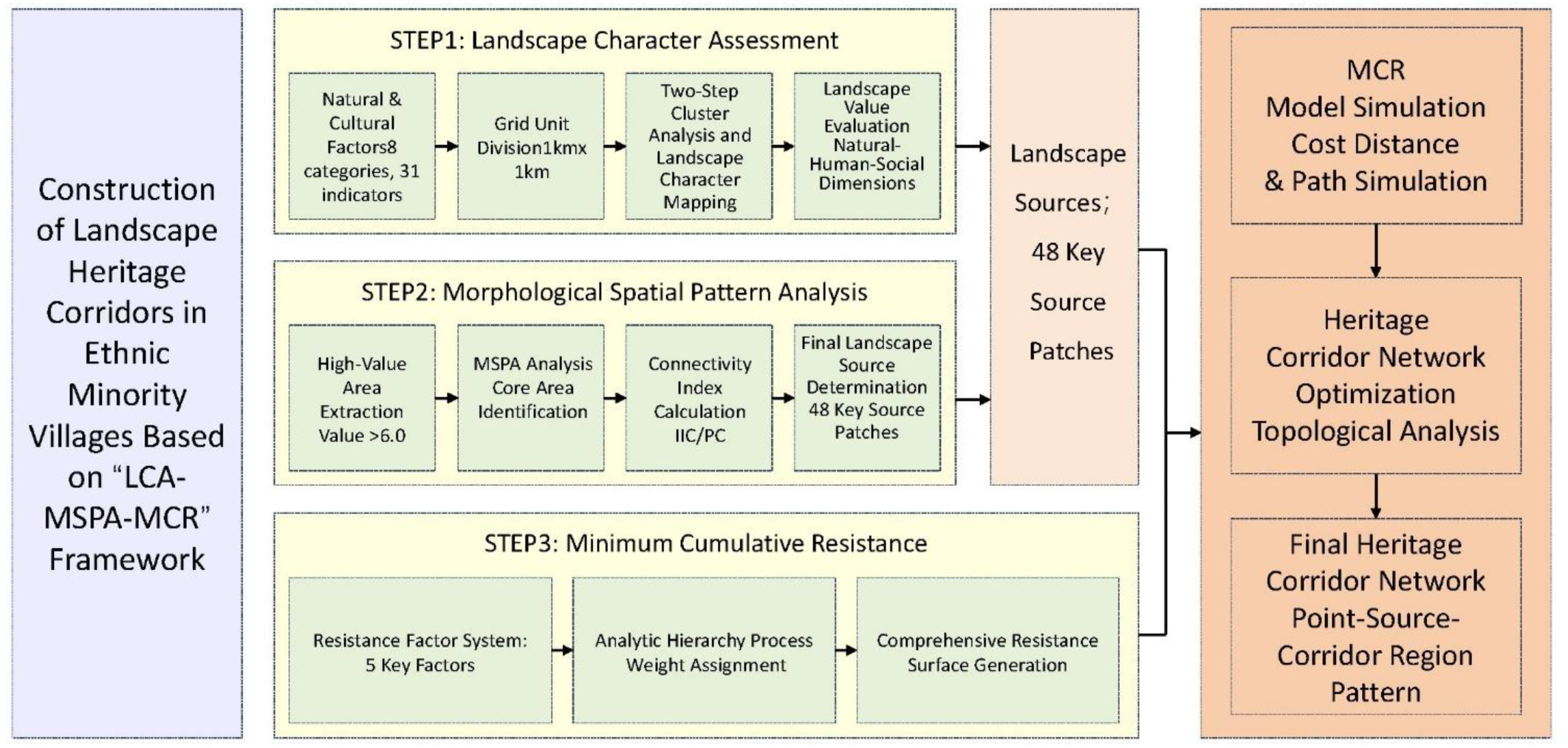
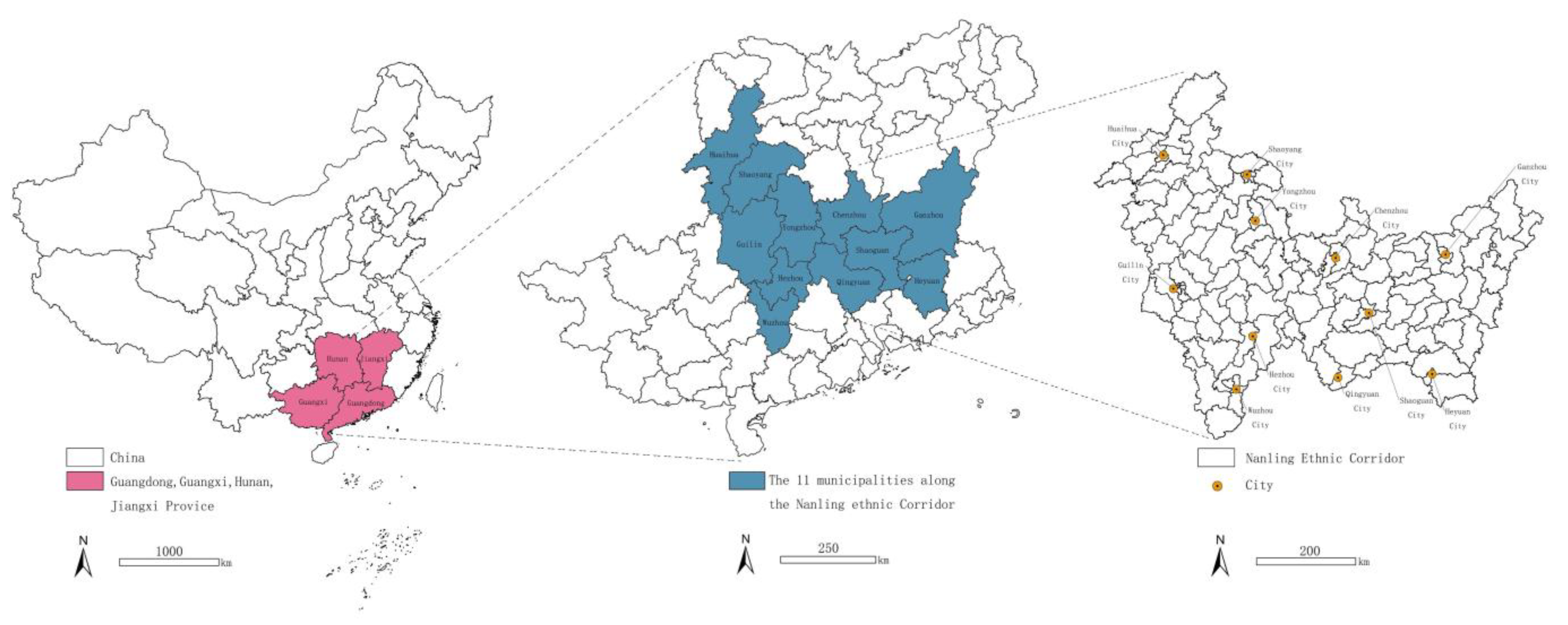
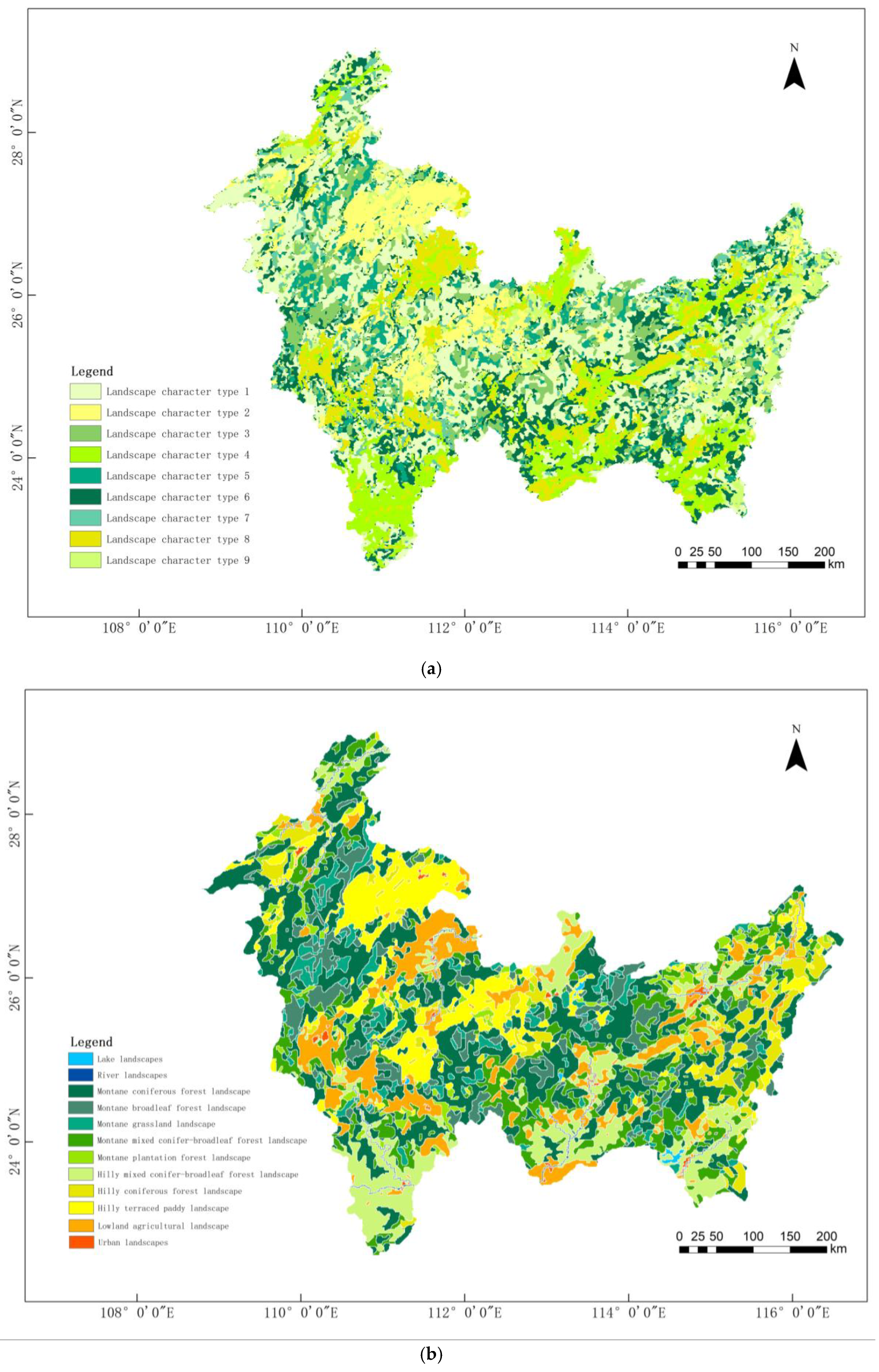
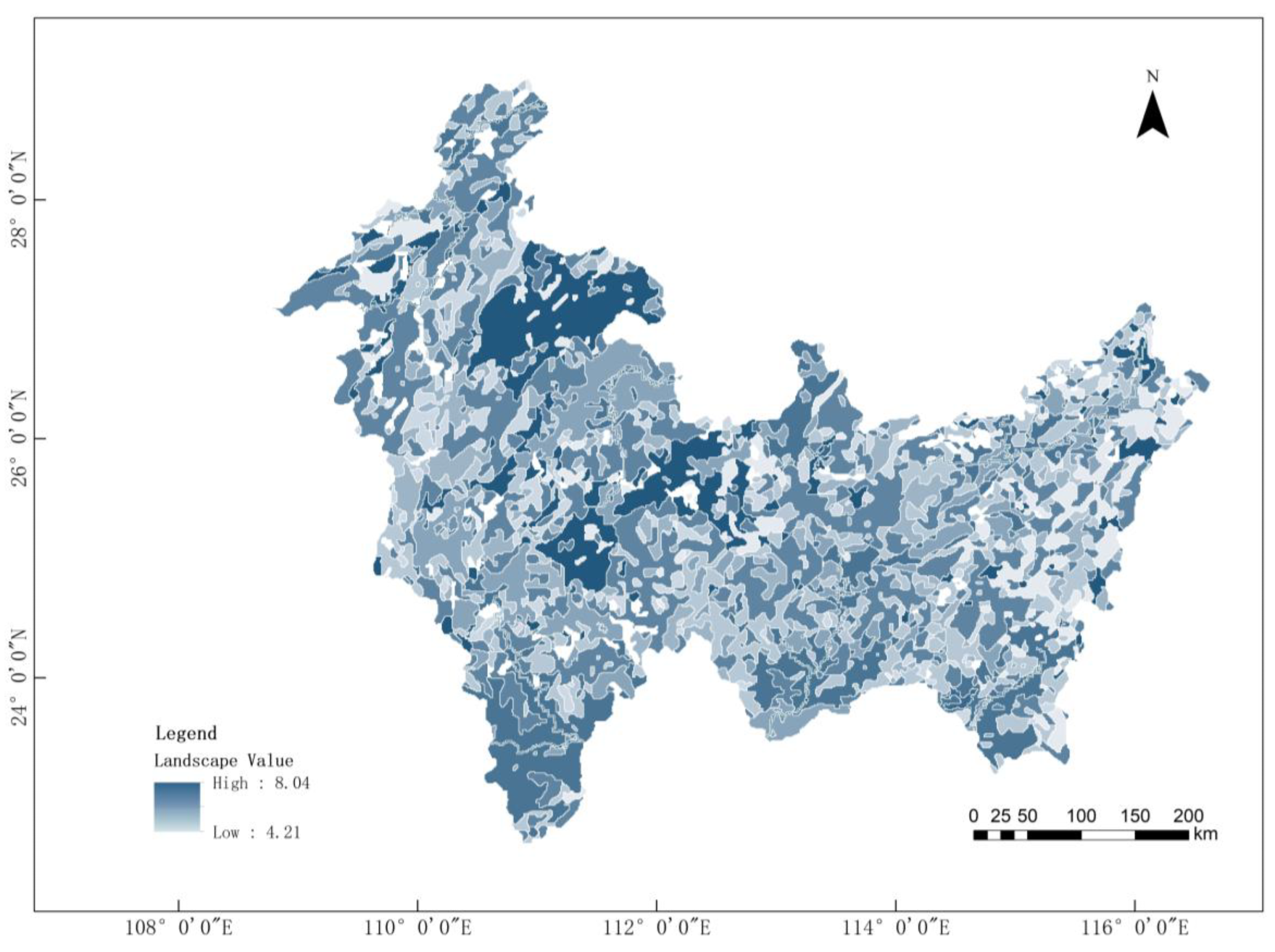

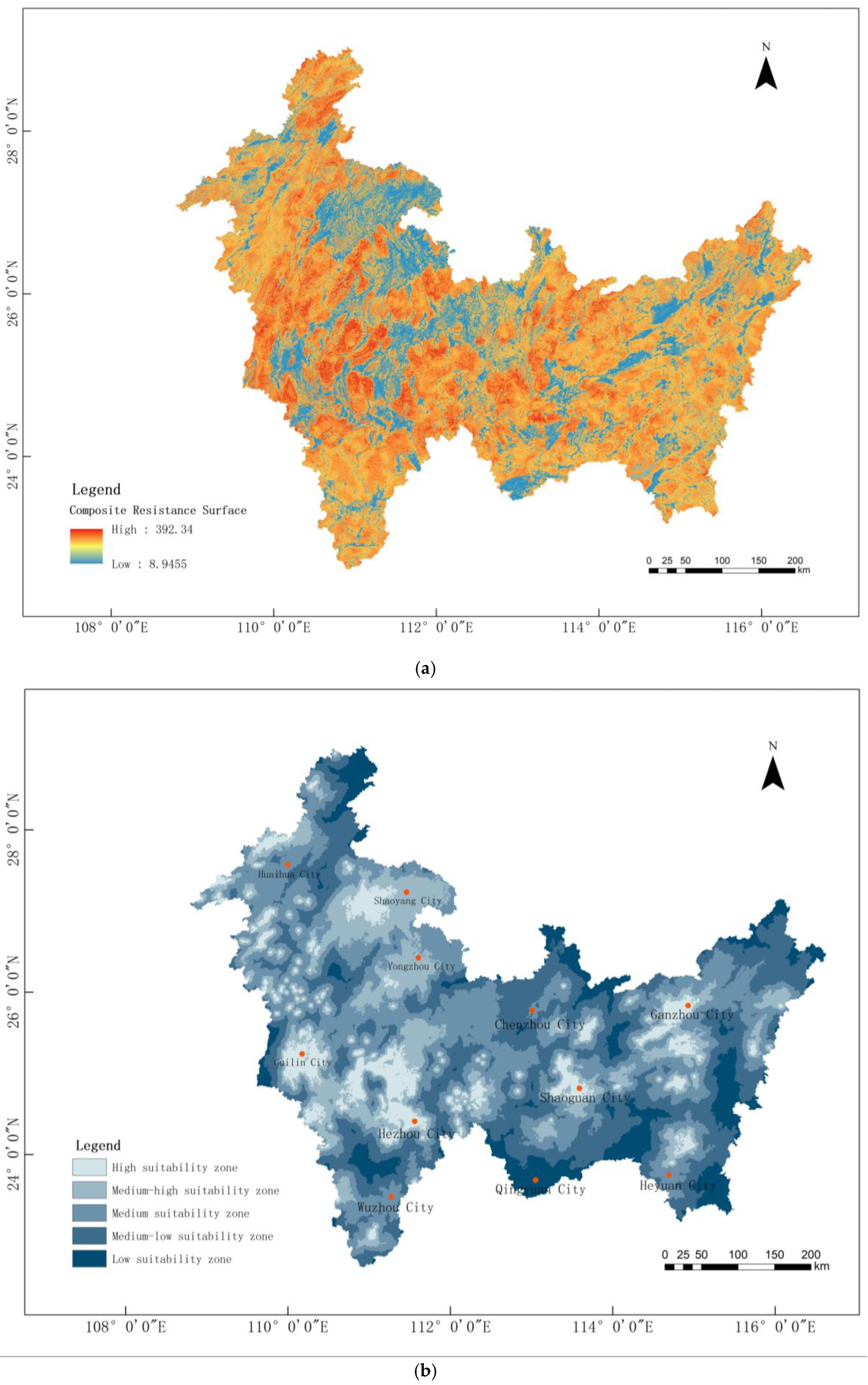
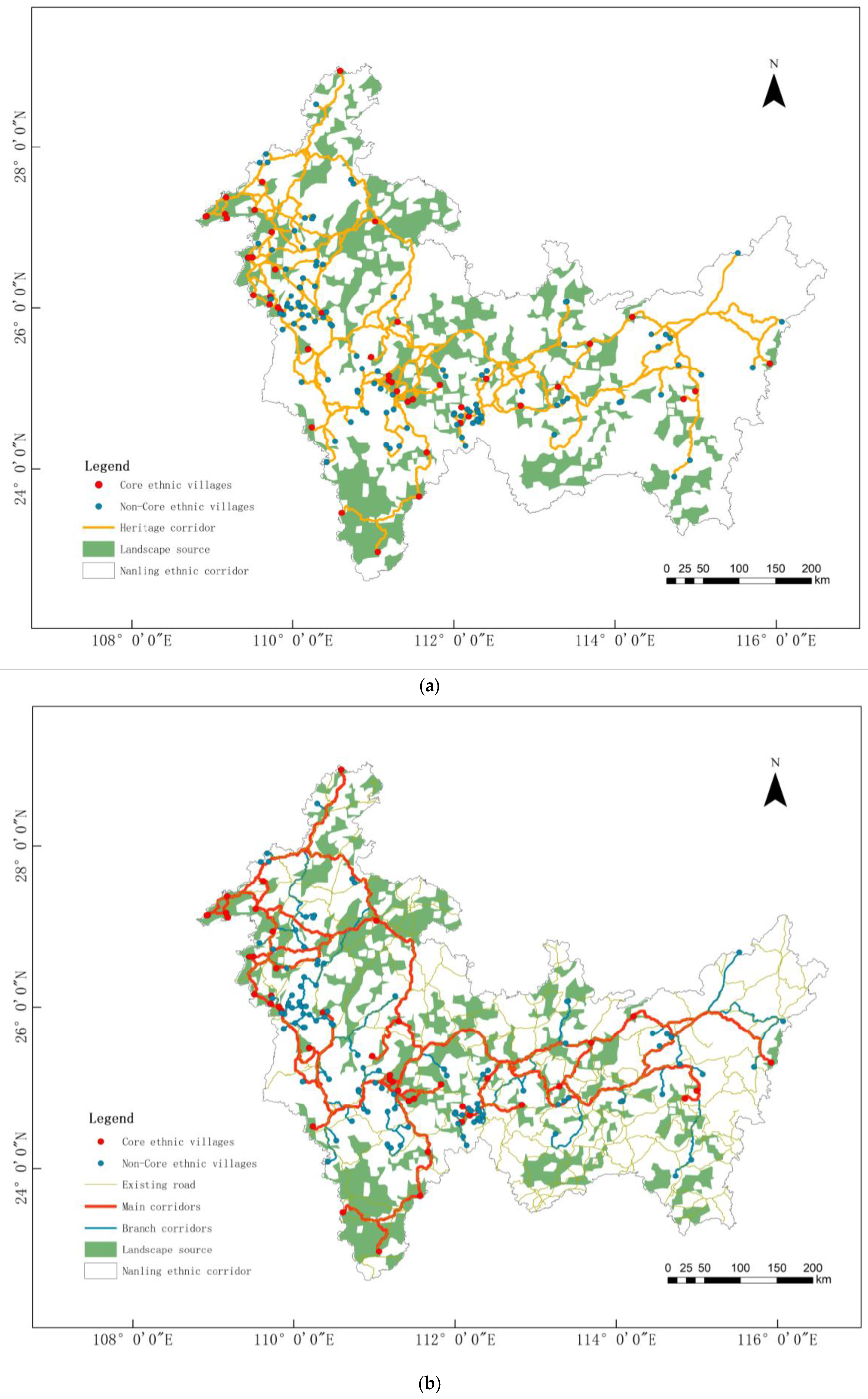
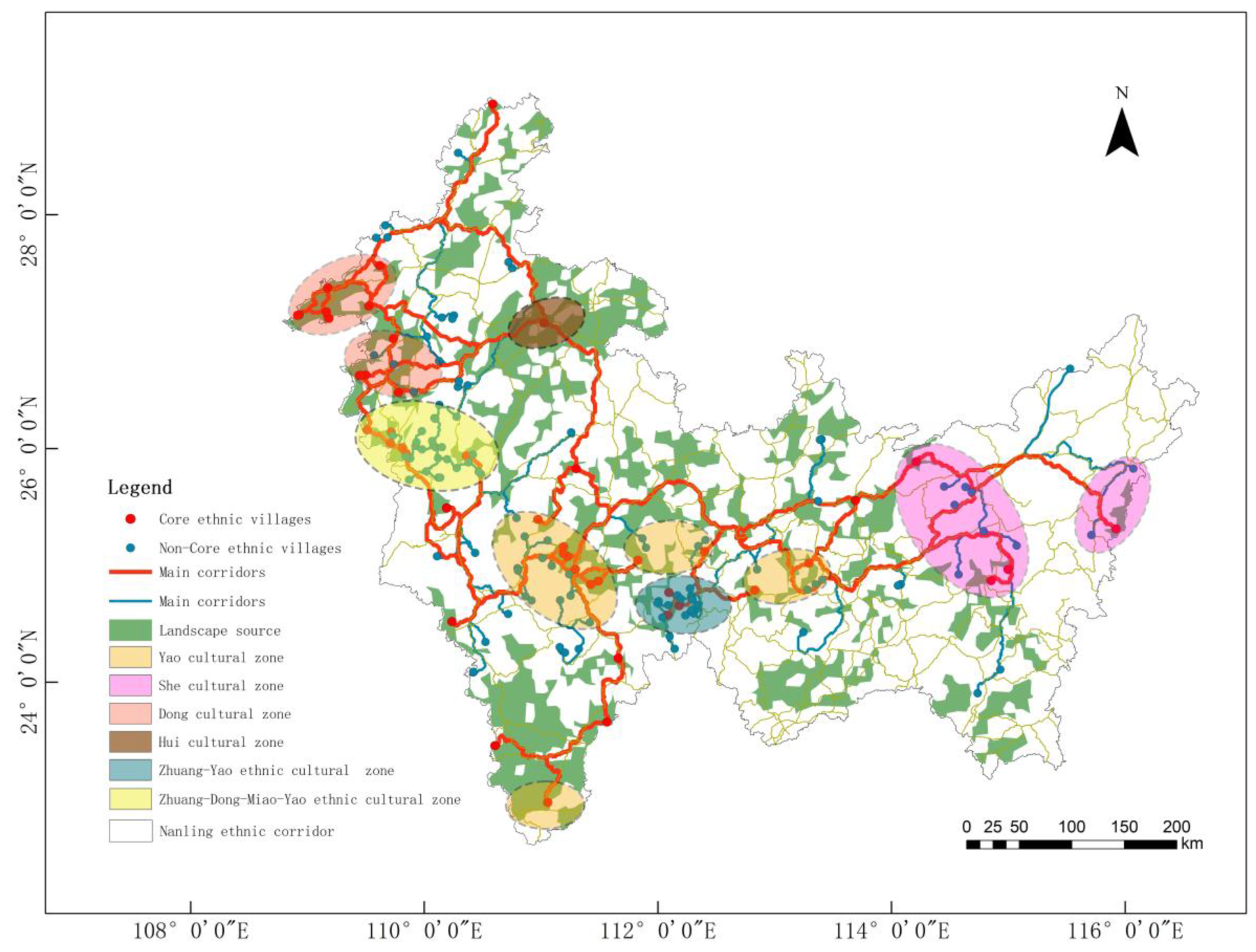
| Methodology | Stage of Application | Applicable Context | Limitations |
|---|---|---|---|
| Minimum Cumulative Resistance (MCR) | Mid-stage planning (“Corridor Routing”). Used after identifying core heritage “sources” and constructing the resistance surface. | Precise identification of linear corridor spatial extent. Ideal for scientifically determining the optimal route connecting dispersed heritage features. | 1. Typically yields a single optimal path, potentially overlooking alternative routes. 2. A static model that struggles to simulate dynamic processes. |
| Circuit Effective Conductance (CEC) | Mid-to-late-stage planning (“Corridor Optimization and Restoration”). Used to evaluate the robustness of a preliminary corridor (e.g., from MCR). | Assessing overall connectivity and resilience of a corridor network. Applicable for scenarios requiring evaluation of the importance or fragility of specific corridor sections. | 1. The model is more complex, computationally intensive, and requires greater expertise to interpret. 2. Primarily serves ecological objectives; offers weaker explanatory power for cultural experiences. |
| Environmental Spatial Modeling (ESM) | Early-stage planning (“Baseline Assessment”). Used to identify ecological redlines for priority protection, serving as constraints for the corridor routing process. | Macro-scale ecological security pattern construction. Suitable for delineating ecological protection zones and networks. | 1. The output is a zonal map (polygons), not a linear path; cannot be directly used for routing. 2. Heavily biased towards natural ecological elements; less capable of spatially integrating cultural heritage elements. |
| Recreation Opportunity Spectrum (ROS) | Late-stage planning (“Zoning and Management”). Used to design differentiated experience offerings and management strategies after the corridor’s spatial extent is defined. | Tourism planning and visitor management for corridors. Applicable to heritage corridor projects aimed at developing cultural tourism that requires providing visitors with rich yet managed experiences. | 1. Is not a spatial routing model; cannot generate specific alignments. 2. It is a management framework that must be integrated with other spatial models. |
| Conservation Action Planning & Zoning (CAP) | Late-stage planning. It is the management safeguard system ensuring the corridor’s sustainable development. | A management toolkit for all heritage corridor projects. It is key to translating corridor plans from “blueprint” to “reality”. | Is not at all a routing method; provides no spatial generative functionality. |
| Feature Category | The Name of The Feature | Variables and Code |
|---|---|---|
| Natural Landscape | Elevation | A1 ≤ 200 m, 200 m < A2 < 500 m, A3 ≥ 500 m |
| Slope | SL1 ≤ 10°, 10° < SL2 < 30°, SL3 ≥ 30° | |
| Vegetation | V1 = Coniferous Forest, V2 = Broad-leaved Forest, V3 = Bush, V4 = Brushwood, V5 = Cultivated Plants | |
| Landform | LF1 = Hilly, LF2 = Low Mountain, LF3 = Medium-height Mountains, LF4 = Plain, LF5 = Mesa | |
| Soil | S1 = Southern Paddy Soil, S2 = Limestone, S3 = Red Soil, S4 = Yellow Soil | |
| Cultural Landscape | Cultural Heritage Density | C1 = Low Density, C2 = Medium Density, C3 = High Density |
| Village Density | H1 = Low Density, H2 = Medium Density, H3 = High Density | |
| Land Cover | L1 = Farmland, L2 = Woodland, L3 = Grassland, L4 = Built-up Land, L5 = Water Body |
| Specialty Field | Number of Experts | Academic/Professional Title | Range of Consistency Ratio (CR) |
|---|---|---|---|
| Landscape Planning | 4 | Professor (2), Associate Professor (2) | 0.02–0.07 |
| Human Geography | 3 | Research Fellow (1), Associate Professor (2) | 0.01–0.05 |
| Urban and Rural Planning | 3 | Senior Urban Planner (2), Professor (1) | 0.03–0.06 |
| Ethnology | 3 | Professor (1), Associate Professor (2) | 0.04–0.08 |
| Total/Mean | 13 | Mean CR: 0.048 |
| Target Layer | Criterion Layer | Factor Layer | Weight | Description and Evaluation | References |
|---|---|---|---|---|---|
| Assessment of Landscape Character Type Values in the Nanling Ethnic Corridor (A) | Natural Landscape Value (B1) | Ecological Service Value (C1) | 0.375 | As natural ecosystems, landscapes have ecological service functions such as pollution purification, climate regulation, and biodiversity maintenance | National Nature Reserve Assessment Criteria [39], Scenic Resource Quality Rating Standards for Chinese Forest Parks [40] |
| Natural Resource Value (C2) | 0.125 | The ability of landscapes to provide natural resources such as material resources (such as timber and minerals) and energy resources (such as wind and water energy) for social and economic development | Scenic Resource Quality Rating Standards for Chinese Forest Parks [40], Regulations on Scenic and Historic Areas [41] | ||
| Social Landscape Value (B2) | Sociocultural Value (C3) | 0.03 | Landscapes sustain the capacity for cultural prosperity within human communities by providing spaces for recreation, education, and social interaction | Madrid Landscape Assessment Framework [42], Hong Kong Landscape Evaluation Framework [43], Regulations on the Protection of Famous Historical and Cultural Cities, Towns, and Villages [44] | |
| Scientific Research Value (C4) | 0.068 | Landscapes are an important object of modern scientific research, providing the value of experimental fields and basic data for revealing scientific laws and detecting environmental changes | Madrid Landscape Assessment Framework [42], Hong Kong Landscape Evaluation Framework [43] | ||
| Humanistic Landscape Value (B3) | Historical Heritage Value (C5) | 0.152 | As a carrier of human history and culture, landscapes carry the recording function of collective memory and witness the evolution of civilization through spatial form and narrative | Regulations on Scenic and Historic Areas [41], Convention Concerning the Protection of the World Cultural and Natural Heritage [45], Principles for the Conservation of Heritage Sites in China [46] | |
| Spiritual Symbol Value (C6) | 0.1667 | As regional cultural symbols, landscapes convey collective identity and spiritual belief through spatial symbols, thereby shaping the function of ethnic cultural emotions | Convention Concerning the Protection of the World Cultural and Natural Heritage [45], Principles for the Conservation of Heritage Sites in China [46] | ||
| Aesthetic Taste Value (C7) | 0.0833 | The visual beauty, spatial scale, diversity, cleanliness and cultural uniqueness of the landscape | Regulations on Scenic and Historic Areas [44], Convention Concerning the Protection of the World Cultural and Natural Heritage [45], Principles for the Conservation of Heritage Sites in China [46] |
| Resistance Factor | Resistance Grading | Resistance Value | Weight Value | Primary Rationale |
|---|---|---|---|---|
| Land Cover | Farmland, Construction Land | 5 | 0.4800 | Human activities and ecological protection are the carriers that play a decisive role |
| Water Bodies, Grasslands | 150 | |||
| Forests, Shrubs | 500 | |||
| Elevation | Low Altitude: −100–200 m | 10 | 0.0564 | Climatic and resource factors indirectly influence the distribution of village settlements and cultural dissemination |
| Low and Medium Altitude: 200–500 m | 30 | |||
| Medium Altitude: 500–1000 m | 50 | |||
| Medium and High Altitude: 1000–1500 m | 70 | |||
| High Altitude: 1500–2107 m | 100 | |||
| Slope | <3° | 5 | 0.2111 | The direct determinants of the cost and construction feasibility of cultural heritage corridors |
| 3–8° | 10 | |||
| 8–15° | 30 | |||
| 15–25° | 100 | |||
| >25° | 500 | |||
| Topographic Relief Index | Flat Ground: 0–30 | 10 | 0.0937 | Macroscopically shaping cultural regions serves as a background-level resistive force |
| Hill: 30–70 | 30 | |||
| Low Mountain: 70–200 | 50 | |||
| Middle and High Mountains: >200 | 100 | |||
| Traffic Accessibility | Areas within 1 km of national or provincial highways | 10 | 0.1589 | The strongest anthropogenic factor in reducing spatial resistance in modern society |
| Areas located 1–3 km from national or provincial highways | 50 | |||
| Areas located 3–5 km from national or provincial highways | 100 | |||
| More than 5 km from national or provincial highways | 200 |
| Character Type | Variable Combination (Main Variables) | Percentage/% |
|---|---|---|
| Type 1 | A2, L2, LF2, V1, V2, V3, V4, C1, H1, S3 | 9.2% |
| Type 2 | A2, L1, LF1, LF2, LF5, V1, V5, C1, H1, S3 | 13.9% |
| Type 3 | A3, L2, LF3, V1, V2, V3, V4, V5, C2, H1, S3 | 18.8% |
| Type 4 | A1, L2, LF2, V1, V5, V1, H2, S3 | 12.1% |
| Type 5 | A2, L2, LF2, V3, C2, H1, S3 | 10.1% |
| Type 6 | A2, L2, LF1, V1, C1, H1, S3 | 10.8% |
| Type 7 | A2, L2, LF2, V5, C1, H1, S3 | 6.0% |
| Type 8 | A1, L1, LF1, LF2, V1, V3, V5, C2, H1, S3 | 9.4% |
| Type 9 | A2, L2, LF2, V1, C2, H1, H2, S2, S3 | 9.7% |
| Total | 100% |
| Ethnic Cultural Area | Ethnic Category | Core Ethnic Villages |
|---|---|---|
| Xinhuang-Zhijiang Dong Unit | Dong | Chongshou Village, Tianjing Village, Bihe Village, Zaoxi Village, Niupizhai Village, Shaotian Village, Cuanyangutun Village |
| Jingzhou-Huitong Dong Unit | Dong | Fengmu Village, Disun Miao Village, Disun Village, Pingtan Village, Yanjiao Village |
| Longhui Hui Unit | Hui | Shanjie Hui Village |
| Tongdao-Longsheng-Ziyuan Multiethnic Unit | Zhuang, Dong, Yao and Miao | Shangxiang Village, Taro Village, Xiyao Village, Hengling Village, Diling Dongzhai, Pingshuitun Village |
| Gongcheng-Jiangyong Yao Unit | Yao | Shangjiangkou Tun, Fuxi Village, Shenpo Village, Humaling Village, Goulan Yaozhai, Shanggantang Village, Jingtouwan Village |
| Cenxi Yao Unit | Yao | Lvyun Village |
| Lianshan-Liannan Zhuang and Yao Unit | Zhuang and Yao | Zhongping Village, Zhengqi Village, Guxianping Village |
| Ruyuan Yao Unit | Yao | Bibeikou Village, Yingming Village |
| Shangyou-Nankang-Dingnan She Unit | She | Hengkeng She Village, Fuzu She Village, Huangsha She Village |
| Ruijin She Unit | She | Anzhi She village |
| Jianghua-Lianzhou Yao Unit | Yao | Tongchongkou Village, Tianxin Village |
| Type | Connectance | Circuitry | Node Connectivity | Alpha Index |
|---|---|---|---|---|
| Existing Road Network | 0.16 | 0.22 | 1.6 | 0.12 |
| Heritage Corridor | 0.34 | 0.49 | 3.3 | 0.31 |
Disclaimer/Publisher’s Note: The statements, opinions and data contained in all publications are solely those of the individual author(s) and contributor(s) and not of MDPI and/or the editor(s). MDPI and/or the editor(s) disclaim responsibility for any injury to people or property resulting from any ideas, methods, instructions or products referred to in the content. |
© 2025 by the authors. Licensee MDPI, Basel, Switzerland. This article is an open access article distributed under the terms and conditions of the Creative Commons Attribution (CC BY) license (https://creativecommons.org/licenses/by/4.0/).
Share and Cite
Tang, X.; Mei, J.; Tang, Y. Construction of Landscape Heritage Corridors in Ethnic Minority Villages Based on LCA-MSPA-MCR Framework: A Case Study of the Nanling Ethnic Corridor Region in China. Buildings 2025, 15, 3403. https://doi.org/10.3390/buildings15183403
Tang X, Mei J, Tang Y. Construction of Landscape Heritage Corridors in Ethnic Minority Villages Based on LCA-MSPA-MCR Framework: A Case Study of the Nanling Ethnic Corridor Region in China. Buildings. 2025; 15(18):3403. https://doi.org/10.3390/buildings15183403
Chicago/Turabian StyleTang, Xiaoxiang, Junxiang Mei, and Ye Tang. 2025. "Construction of Landscape Heritage Corridors in Ethnic Minority Villages Based on LCA-MSPA-MCR Framework: A Case Study of the Nanling Ethnic Corridor Region in China" Buildings 15, no. 18: 3403. https://doi.org/10.3390/buildings15183403
APA StyleTang, X., Mei, J., & Tang, Y. (2025). Construction of Landscape Heritage Corridors in Ethnic Minority Villages Based on LCA-MSPA-MCR Framework: A Case Study of the Nanling Ethnic Corridor Region in China. Buildings, 15(18), 3403. https://doi.org/10.3390/buildings15183403








